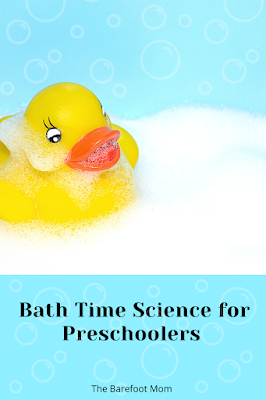Bath time is a great opportunity for young children to explore buoyancy and the properties of water. In this post I share several simple science activities for preschoolers to do in the bath!
What Floats?
Before bath time, have your child collect various toys and household items like bouncy balls, golf balls, plastic cups or bowls, etc... Have your child guess which items will float and which will sink. Then have your child test them out in the bath tub. Talk about which items float best and why.
What Types Of Things Absorb Water?
Before bath time help your child gather up a variety of household items. Pick some items that will absorb water like washcloths or sponges, and some that wont like plastic toys and rubber balls.
Ask your child which items they think will absorb water, then get in the bath tub and test it out!
Color Mixing Fun
The bath tub is the perfect place for a messy painting project! Using bath paint in primary colors, help your child mix colors to make the secondary and tertiary colors.
For instructions for making your own homemade bath paint, check out this post from Life As Mama.
Which Holds More Water?
Collect various cups, bowls, measuring cups, and a large pitcher from your kitchen. In the bath tub let your child test which cups, bowls, and measuring cups hold the most and least water by filling them and pouring them into the pitcher. You can use a bath marker to mark the water level on the pitcher if you want.
Ice Exploration
Make an ice cube tray or two full of ice ahead of time. Let your child play with and observe the melting ice as they play in the tub.
Use this as an opportunity to talk about the states of matter. Ice is solid and water is a liquid even though they are both made up of water molecules. Talk about how water freezes when it's cold and then melts as it warms up.
If you enjoyed this post, check out:
-Simple Autumn Leaf Craft
-Rainbow Science
Follow me on:
Facebook
Pinterest
Instagram
What Floats?
Before bath time, have your child collect various toys and household items like bouncy balls, golf balls, plastic cups or bowls, etc... Have your child guess which items will float and which will sink. Then have your child test them out in the bath tub. Talk about which items float best and why.
What Types Of Things Absorb Water?
Before bath time help your child gather up a variety of household items. Pick some items that will absorb water like washcloths or sponges, and some that wont like plastic toys and rubber balls.
Ask your child which items they think will absorb water, then get in the bath tub and test it out!
Color Mixing Fun
The bath tub is the perfect place for a messy painting project! Using bath paint in primary colors, help your child mix colors to make the secondary and tertiary colors.
For instructions for making your own homemade bath paint, check out this post from Life As Mama.
Which Holds More Water?
Collect various cups, bowls, measuring cups, and a large pitcher from your kitchen. In the bath tub let your child test which cups, bowls, and measuring cups hold the most and least water by filling them and pouring them into the pitcher. You can use a bath marker to mark the water level on the pitcher if you want.
Ice Exploration
Make an ice cube tray or two full of ice ahead of time. Let your child play with and observe the melting ice as they play in the tub.
Use this as an opportunity to talk about the states of matter. Ice is solid and water is a liquid even though they are both made up of water molecules. Talk about how water freezes when it's cold and then melts as it warms up.
If you enjoyed this post, check out:
-Simple Autumn Leaf Craft
-Rainbow Science
Follow me on:


Comments
Post a Comment